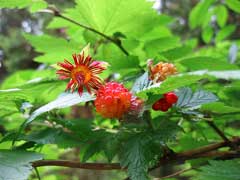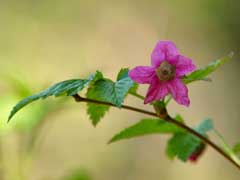 |
|
http://www.flickr.com/people/pfly/ |
 |
| http://en.wikipedia.org/wiki/User:BlindGoofy |
Translate this page:
Summary
Physical Characteristics

 Rubus spectabilis is a deciduous Shrub growing to 1.8 m (6ft) by 1 m (3ft 3in) at a medium rate.
Rubus spectabilis is a deciduous Shrub growing to 1.8 m (6ft) by 1 m (3ft 3in) at a medium rate.
See above for USDA hardiness. It is hardy to UK zone 5 and is not frost tender. It is in flower in April, and the seeds ripen from June to July. The species is hermaphrodite (has both male and female organs) and is pollinated by Insects.
Suitable for: light (sandy), medium (loamy) and heavy (clay) soils and prefers well-drained soil. Suitable pH: mildly acid, neutral and basic (mildly alkaline) soils and can grow in very acid soils.
It can grow in semi-shade (light woodland) or no shade. It prefers moist soil.
UK Hardiness Map
US Hardiness Map
Synonyms
Plant Habitats
Woodland Garden Sunny Edge; Dappled Shade;
Edible Uses
Edible Parts: Flowers Fruit Shoots Stem
Edible Uses: Tea
Fruit - raw, cooked or dried for later use[1, 2, 17, 85, 101, 183]. Juicy with a very good flavour[182, 183]. The fruit can be made into jams and jellies[257]. This species is not of much value in Britain, it does not fruit freely in the cooler summers of this country and the fruits do not always develop their full flavour[11]. The fruit can range in colour from yellow, through orange to red, it is about the size of a cultivated raspberry but is rather inferior in flavour and often has a distinctive bitterness, especially in cooler summers[K]. Another report says that it fruits freely in Britain[182]. Young shoots - peeled and eaten raw or cooked like asparagus[11, 101, 118, 183, 257]. They are harvested in the spring as they grow above the soil and whilst they are still tender[161]. Flowers - raw[172]. The leaves are used as a tea substitute[183].
References More on Edible Uses
Medicinal Uses
Plants For A Future can not take any responsibility for any adverse effects from the use of plants. Always seek advice from a professional before using a plant medicinally.
Analgesic Astringent Disinfectant Odontalgic Poultice Stomachic
The leaves and the root are astringent[172]. A poultice of the chewed leaves has been used as a dressing on burns[257]. The root bark is analgesic, astringent, disinfectant and stomachic[257]. A decoction is used in the treatment of stomach complaints[257]. A decoction has been used to lessen the pains of labour[257]. The powdered bark has been used as a dusting powder on burns and sores[257]. A poultice of the bark has been applied to wounds and aching teeth to ease the pain[257]. A poultice of the chewed bark has been used as a dressing to relive pain and clean burns and wounds[257].
References More on Medicinal Uses
The Bookshop: Edible Plant Books
Our Latest books on Perennial Plants For Food Forests and Permaculture Gardens in paperback or digital formats.

Edible Tropical Plants
Food Forest Plants for Hotter Conditions: 250+ Plants For Tropical Food Forests & Permaculture Gardens.
More

Edible Temperate Plants
Plants for Your Food Forest: 500 Plants for Temperate Food Forests & Permaculture Gardens.
More

More Books
PFAF have eight books available in paperback and digital formats. Browse the shop for more information.
Shop Now
Other Uses
Disinfectant Dye Pipes
Agroforestry Uses:
The deep root system of salmonberry can help prevent soil erosion on steep slopes[1050
]
Salmonberry is a pioneer or early seral species noted for its ability to spread aggressively on disturbed sites. A certain amount of soil disturbance is essential for good seedling establishment. Seedlings generally appear in abundance after fire, timber harvest, or other types of disturbance. Rhizomes enable the plant to spread vigorously and form dense patches. In many areas dense stands may form within 2 to 3 years after disturbance[1050
]. The stands will often diminish as tree species become established and form a canopy, though it can persist almost indefinitely, especially under hardwood canopies such as Alder.
Other Uses:
The plant is used in breeding programmes with the raspberry (Rubus idaeus) in North America[317
].
A purple to dull blue dye is obtained from the fruit[168
].
The hollowed stems are used as pipes[99
]. (The report does not specify what type of pipes).
Special Uses
Food Forest
References More on Other Uses
Cultivation details
Easily grown in a good well-drained loamy soil in sun or semi-shade[1, 11, 200]. Grows well in the shade of trees[200] though it is less likely to fruit well in such a position[K]. Hardy to about -25°c[184]. A very ornamental plant, but it is invasive[1]. It does not fruit well in Britain[11], but has become naturalized in Surrey and Cumbria in cool acid woodland soils[182]. This species is a raspberry with biennial stems, it produces a number of new stems each year from the perennial rootstock, these stems fruit in their second year and then die[200]. Plants in this genus are notably susceptible to honey fungus[200]. The plant is heat tolerant in zones 8 through 5. (Plant Hardiness Zones show how well plants withstand cold winter temperatures.
Plant Heat Zones show when plants would start suffering from the heat.
The Plant Heat Zone map is based on the number of "heat days" experienced in a given area where the temperature climbs to over 86 degrees F (30°C).
At this temperature, many plants begin to suffer physiological damage. Heat Zones range from 1 (no heat days) to 12 (210 or more heat days).
For example Heat Zone. 11-1 indicates that the plant is heat tolerant in zones 11 through 1.) For polyculture design as well as the above-ground architecture (form - tree, shrub etc. and size shown above) information on the habit and root pattern is also useful and given here if available. A clumping plant, forming a colony from shoots away from the crown but with a limited spread [1-2]. The root pattern is suckering with new plants from underground runners away from the plant [1-2].
References Carbon Farming Information and Carbon Sequestration Information
Temperature Converter
Type a value in the Celsius field to convert the value to Fahrenheit:
Fahrenheit:
The PFAF Bookshop
Plants For A Future have a number of books available in paperback and digital form. Book titles include Edible Plants, Edible Perennials, Edible Trees,Edible Shrubs, Woodland Gardening, and Temperate Food Forest Plants. Our new book is Food Forest Plants For Hotter Conditions (Tropical and Sub-Tropical).
Shop Now
Plant Propagation
Seed - requires stratification and is best sown in early autumn in a cold frame. Stored seed requires one month stratification at about 3°c and is best sown as early as possible in the year. Prick out the seedlings when they are large enough to handle and grow on in a cold frame. Plant them out into their permanent positions in late spring of the following year. Cuttings of half-ripe wood, July/August in a frame[200]. Tip layering in July. Plant out in autumn. Division in early spring or just before leaf-fall in the autumn[200].
Other Names
If available other names are mentioned here
Native Range
NORTHERN AMERICA: United States, Alaska, Oregon (west), Washington (west), California (northwest), Canada, British Columbia (west),
Weed Potential
Right plant wrong place. We are currently updating this section.
Please note that a plant may be invasive in one area but may not in your area so it's worth checking.
Conservation Status
IUCN Red List of Threatened Plants Status :

Growth: S = slow M = medium F = fast. Soil: L = light (sandy) M = medium H = heavy (clay). pH: A = acid N = neutral B = basic (alkaline). Shade: F = full shade S = semi-shade N = no shade. Moisture: D = dry M = Moist We = wet Wa = water.
Now available:
Food Forest Plants for Mediterranean Conditions
350+ Perennial Plants For Mediterranean and Drier Food Forests and Permaculture Gardens.
[Paperback and eBook]
This is the third in Plants For A Future's series of plant guides for food forests tailored to
specific climate zones. Following volumes on temperate and tropical ecosystems, this book focuses
on species suited to Mediterranean conditions—regions with hot, dry summers and cool, wet winters,
often facing the added challenge of climate change.
Read More
Expert comment
Author
Pursh.
Botanical References
1171200
Links / References
For a list of references used on this page please go here
Readers comment
| Add a comment |
|
If you have important information about this plant that may help other users please add a comment or link below. Only comments or links that are felt to be directly relevant to a plant will be included. If you think a comment/link or information contained on this page is inaccurate or misleading we would welcome your feedback at [email protected]. If you have questions about a plant please use the Forum on this website as we do not have the resources to answer questions ourselves.
* Please note: the comments by website users are not necessarily those held by PFAF and may give misleading or inaccurate information.
To leave a comment please Register or login here All comments need to be approved so will not appear immediately.
|
Subject : Rubus spectabilis
|
|
|
|